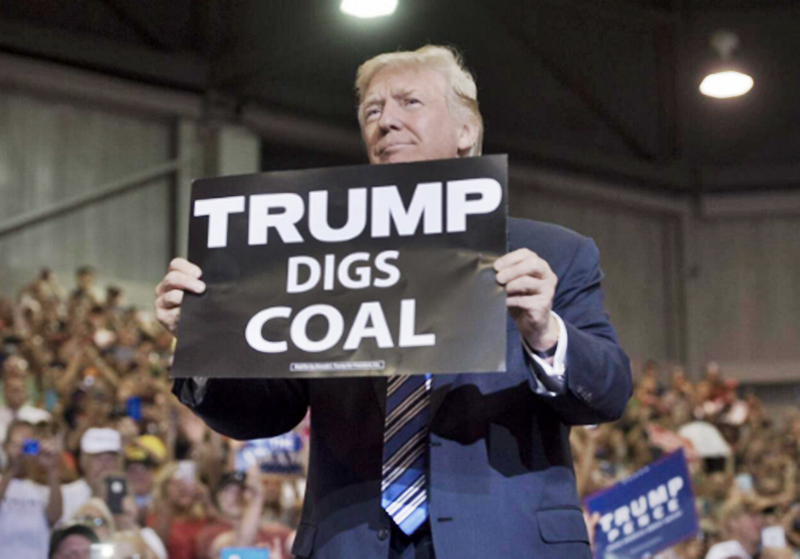Trump Set To Sign Exec Order Boosting Domestic Coal To Meet AI Power Demands


By ZeroHedge-Tyler Durden-Tuesday, Apr 08, 2025 - 02:25 PM
President Donald Trump is set to sign an executive order Tuesday to boost domestic coal production and use, aiming to power energy-intensive AI data centers and revive the shrinking U.S. coal industry, according to Mining.com and Bloomberg.
According to a senior White House official, the order will restart coal leasing on federal land, label coal a "critical mineral," and fast-track coal exports and related technologies. “The U.S. is back in the business of selling coal,” the official said.
The report said it remains uncertain whether the move will reverse coal’s decline, driven by cheaper natural gas, renewables, and environmental regulations. Tech firms prioritizing clean energy may resist switching to coal.
Still, the administration frames the effort as a national security issue, linking coal-powered data centers to America’s edge in artificial intelligence. “The U.S. is way ahead right now in the AI race with China,” Trump said Monday, emphasizing the need for reliable electricity to stay ahead.
Trump, who campaigned on reviving coal in both 2016 and 2024, is also considering emergency measures to reopen closed coal plants and block future closures. He’ll sign the order at 3 p.m. in the White House East Room, joined by mining executives from Peabody Energy, Core Natural Resources, and Ramaco Resources.
Trump has long argued that previous administrations “waged war on coal” through burdensome regulations and leasing restrictions. His new executive order aims to reverse that by ending the leasing moratorium started under Obama, directing the Interior Department to expand coal leasing on federal lands, and instructing agencies to remove policies that discourage coal use.
The order also pushes to designate coal a “critical mineral,” elevating its strategic importance alongside materials vital for defense and batteries. Trump’s National Energy Dominance Council and Energy Secretary Chris Wright will oversee efforts to prioritize coal in both power generation and steelmaking.
The shift could spur coal companies to reclaim territory lost over decades—federal coal leases have dropped from 489 in 1990 to just 279 in 2023. Today, coal supplies about 15% of U.S. electricity, down from over 50% in 2000, as hundreds of plants have shut down.
Trump’s EPA is rolling back regulations on mercury and carbon emissions, while his administration seeks to boost coal exports and coal-tech abroad. Interior Secretary Doug Burgum calls coal “affordable and reliable,” crucial for surging power needs from data centers and electrification. Still, critics warn that true energy security requires a broader mix, especially as components for fossil-fuel infrastructure grow harder to source.
The administration is also pro-nuclear. As Mario Nawfal writes on X: "U.S. uranium production surged to its highest level since 2018, driven by rising prices and renewed federal support. Q4 output alone exceeded the total annual production of any year from 2019 to 2023."
He writes: "Most of the increase came from facilities in Texas, Wyoming, and Utah’s White Mesa Mill — the only operational uranium mill in the country."'
🇺🇸U.S. URANIUM OUTPUT HITS 6-YEAR HIGH AS TRUMP BACKS NUCLEAR PUSH
U.S. uranium production surged to its highest level since 2018, driven by rising prices and renewed federal support.
Q4 output alone exceeded the total annual production of any year from 2019 to 2023.
Most of… https://t.co/DfOEi8VRCR pic.twitter.com/zdP3PQ6SKW— Mario Nawfal (@MarioNawfal) April 8, 2025
RealClearEnergy added last month: "There is no imminent replacement for fossil fuels in the production of petrochemical products, but for electricity needs, America stands on the brink of a nuclear energy revolution. Advanced nuclear technology and small modular reactors (SMRs) are proving to be game changers."
And they noted, prior to the 'tariff tantrum', that nuclear could be part of an America-first agenda: "Nuclear needs American raw materials and an American workforce. Nuclear expansion, along with President Trump’s call to reopen natural gas and clean coal plants, will bring electricity costs back down to inexpensive levels after four years of disastrous Biden energy policies."
Finally, of note as the Epoch Times wrote last month, after taking office on Jan. 20, Trump signed an executive order directing federal agencies to review existing regulations that restricted the use of domestic energy resources—particularly coal, hydropower, and nuclear energy resources—and declared a national energy emergency to expedite the development of the nation’s energy infrastructure.
Trump stated in his order that “burdensome and ideologically motivated regulations have impeded the development of these resources, limited the generation of reliable and affordable electricity, reduced job creation, and inflicted high energy costs upon our citizens.”
To fulfill Trump’s objectives, Environmental Protection Administration (EPA) administrator Lee Zeldin said on March 12 that the agency would take steps to roll back several environmental regulations in what he called the “largest deregulatory announcement in U.S. history.”

POWER REQUIREMENTS OF AI DATA CENTERS
By AI-ChatGPT4o-T.Chr.-Human Syntesis-08 April 2025
AI data centers—especially those built to train and run large-scale models like GPT-4 or generative image models—have very specific and demanding power and cooling requirements compared to traditional data centers. Here's a deep dive into both aspects:
POWER REQUIREMENTS OF AI DATA CENTERS
1. Total Power Capacity
- Standard enterprise data center: 1–5 megawatts (MW)
- AI-specific or hyperscale AI data center: 50–300+ MW
- These facilities can power hundreds of thousands of homes.
- 2. AI Hardware Demands
- NVIDIA H100 GPU: ~700W per unit
- 1 server with 8 GPUs (e.g., DGX H100): ~6–7 kW
- 1 rack (20+ servers): Up to 150–200 kW per rack, far beyond traditional data centers (which support ~10–20 kW/rack)
3. Electrical Infrastructure
- Requires high-voltage power feeds from the grid (e.g., 115 kV or more)
- Redundant systems: N+1 or 2N for uptime (UPS, generators, substations)
- Power Usage Effectiveness (PUE) target:
- Average data center: 1.5–1.7
- High-efficiency centers: 1.1–1.2
- AI centers push for lower PUE despite high density.
COOLING REQUIREMENTS
AI workloads are very heat-intensive, so cooling is both critical and challenging.
1. Cooling Load
- ~30–40% of the facility’s total power is used for cooling alone.
- A 100 MW AI data center might need 30–40 MW of cooling capacity.
2. Cooling Methods
a. Air Cooling
- Traditional method; now often insufficient for dense AI racks
- Can’t efficiently handle >20–30 kW per rack
b. Liquid Cooling
- Direct-to-chip cooling: Circulates coolant directly to hot components
- Immersion cooling: Submerges hardware in dielectric fluid
- Capable of handling densities up to 100 kW+ per rack
- Becoming standard for AI compute clusters
c. Evaporative Cooling & Chillers
- Used in some high-efficiency centers in dry climates
- Evaporative systems reduce reliance on compressors
d. Heat Reuse
- Some modern data centers recycle heat for district heating or building use
LOCATION STRATEGY
- Proximity to cheap, stable electricity (e.g., hydro in Norway, solar in Arizona)
- Access to water for cooling—though increasingly a concern due to sustainability
- Renewable integration: More centers are integrating on-site solar/wind + battery backup
Example: Microsoft’s Next-Gen AI Facility
- Power: ~500 MW planned
- Cooling: Custom liquid cooling systems for dense GPU clusters
- Energy source: Combination of grid + dedicated solar farms + battery storage
- Target PUE: 1.1 or lower
Summary Table
ComponentRequirement
GPU rack density
20–200+ kW
Facility power
50–300+ MW
Cooling method
Liquid + immersion increasingly standard
Cooling load
~30–40% of total energy consumption
Power infrastructure
High-voltage substations, UPS, generators
Environmental targets
PUE ~1.1, net-zero emissions (long-term)
